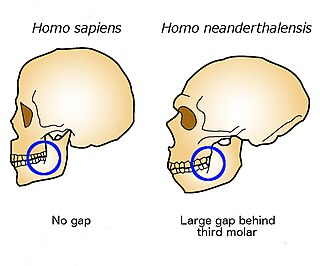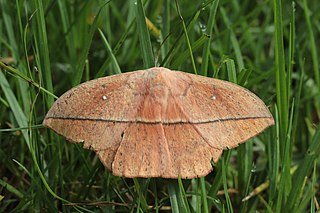Related Research Articles

The retromolar space or retromolar gap is a space at the rear of the mandible, between the back of the last molar and the anterior edge of the ascending ramus where it crosses the alveolar margin.

A stringybark can be any of the many Eucalyptus species which have thick, fibrous bark. Like all eucalypts, stringybarks belong to the family Myrtaceae. In exceptionally fertile locations some stringybark species (in particular messmate stringybark can be very large, reaching over 80 metres in height. More typically, stringybarks are medium-sized trees in the 10 to 40 metre range.

Hesperetin is the 4'-methoxy derivative of eriodictyol, a flavanone. Hesperetin's 7-O-glycoside, hesperidin, is a naturally occurring flavanon-glycoside, the main flavonoid in lemons and sweet oranges. Hesperetin are not found to a significant extent in Citrus spp.

The genus Lonomia is a moderate-sized group of fairly cryptic saturniid moths from South America, famous not for the adults, but for their highly venomous caterpillars, which are responsible for a few deaths each year, especially in southern Brazil, and the subject of hundreds of published medical studies. They are commonly known as giant silkworm moth, a name also used for a wide range of other saturniid moths.

Eucalyptus obliqua, commonly known as messmate stringybark or messmate, but also known as brown top, brown top stringbark, stringybark or Tasmanian oak, is a species of tree that is endemic to south-eastern Australia. It has rough, stringy or fibrous bark on the trunk and larger branches, smooth greyish bark on the thinnest branches, lance-shaped to curved adult leaves, flower buds in groups of seven to fifteen or more, white flowers and cup-shaped or barrel-shaped fruit.

Nothofagus alpina, also called rauli or raulí beech is a species of plant in the Nothofagaceae family. A deciduous tree, it grows in Chile and Argentina, it reaches 50 m (160 ft) height and more than 2 meters (6.5 feet) in diameter. Its distribution goes from 35 to 42° South latitude. It is found on the Andes. It tolerates low temperatures and heavy winds. It has a straight and cylindrical trunk with grey bark. N. alpina was proposed to be renamed Lophozonia alpina in 2013.

Nothofagus obliqua, commonly known as Patagonian oak, roble, pellín, roble pellín, and hualle in its early state of growth or roble beech, is a deciduous tree from Chile and Argentina. It grows from 33 to 43° south latitude. The northern extent of this tree's range in Chile is considered to be the Vizcachas Mountains and La Campana National Park. N. obliqua was proposed to be renamed Lophozonia obliqua in 2013.

Ficus obliqua, commonly known as the small-leaved fig, is a tree in the family Moraceae, native to eastern Australia, New Guinea, eastern Indonesia to Sulawesi and islands in the southwestern Pacific Ocean. Previously known for many years as Ficus eugenioides, it is a banyan of the genus Ficus, which contains around 750 species worldwide in warm climates, including the edible fig. Beginning life as a seedling, which grows on other plants (epiphyte) or on rocks (lithophyte), F. obliqua can grow to 60 m (200 ft) high and nearly as wide with a pale grey buttressed trunk, and glossy green leaves.

Lomandra obliqua, known as fish bones and twisted mat-rush, is a small wiry ground covering plant found in eastern Australia. A widespread plant seen on the coast and tablelands. The foliage superficially resembles a fern, but creamy/yellow flowers form on clusters in spring. Leaves are two ranked, somewhat glaucous and twisted.

Lonomia obliqua, the giant silkworm moth, is a species of saturniid moth from South America. It is famous for its larval form, rather than the adult moth, primarily because of the caterpillar's defense mechanism, urticating bristles that inject a potentially deadly venom. The caterpillar has been responsible for many human deaths, especially in southern Brazil. Its venom has been the subject of numerous medical studies. The species was first described by Francis Walker in 1855. Guinness World Records classified the Lonomia obliqua as the most venomous caterpillar in the world.

Spilosoma obliqua, the jute hairy caterpillar or Bihar hairy caterpillar, is a moth of the family Erebidae. It is found in south-eastern Afghanistan, northern Pakistan, India, Bhutan, Bangladesh and Myanmar.
Bematistes obliqua, the yellow-banded bematistes, is a butterfly in the family Nymphalidae. It is found in Nigeria, Cameroon, the Democratic Republic of the Congo and Uganda. The habitat consists of sub-montane forest.
Euestola basalis is a species of beetle in the family Cerambycidae. It was described by Martins and Galileo in 1997. It is known from Brazil.
Euestola fasciata is a species of beetle in the family Cerambycidae. It was described by Martins and Galileo in 1997. It is known from Brazil.
Euestola lineata is a species of beetle in the family Cerambycidae. It was described by Martins and Galileo in 1997. It is known from Brazil.
Euestola basidensepunctata is a species of beetle in the family Cerambycidae. It was described by Stephan von Breuning in 1943. It is known from Brazil.

Hakea obliqua, commonly known as needles and corks, is a shrub in the family Proteaceae and is endemic to an area in the Wheatbelt, Great Southern and Goldfields-Esperance regions of Western Australia.

Heterocampa obliqua, the oblique heterocampa or oblique prominent, is a species of moth in the family Notodontidae. It was first described by Alpheus Spring Packard in 1864 and it is found in North America.

Nemoria obliqua is a species of emerald moth in the family Geometridae. It is found in Central America and North America.

Cordulegaster obliqua, the arrowhead spiketail, is a species of spiketail in the dragonfly family Cordulegastridae. It is found in North America.
References
- ↑ BioLib.cz - Euestola obliqua. Retrieved on 8 September 2014.